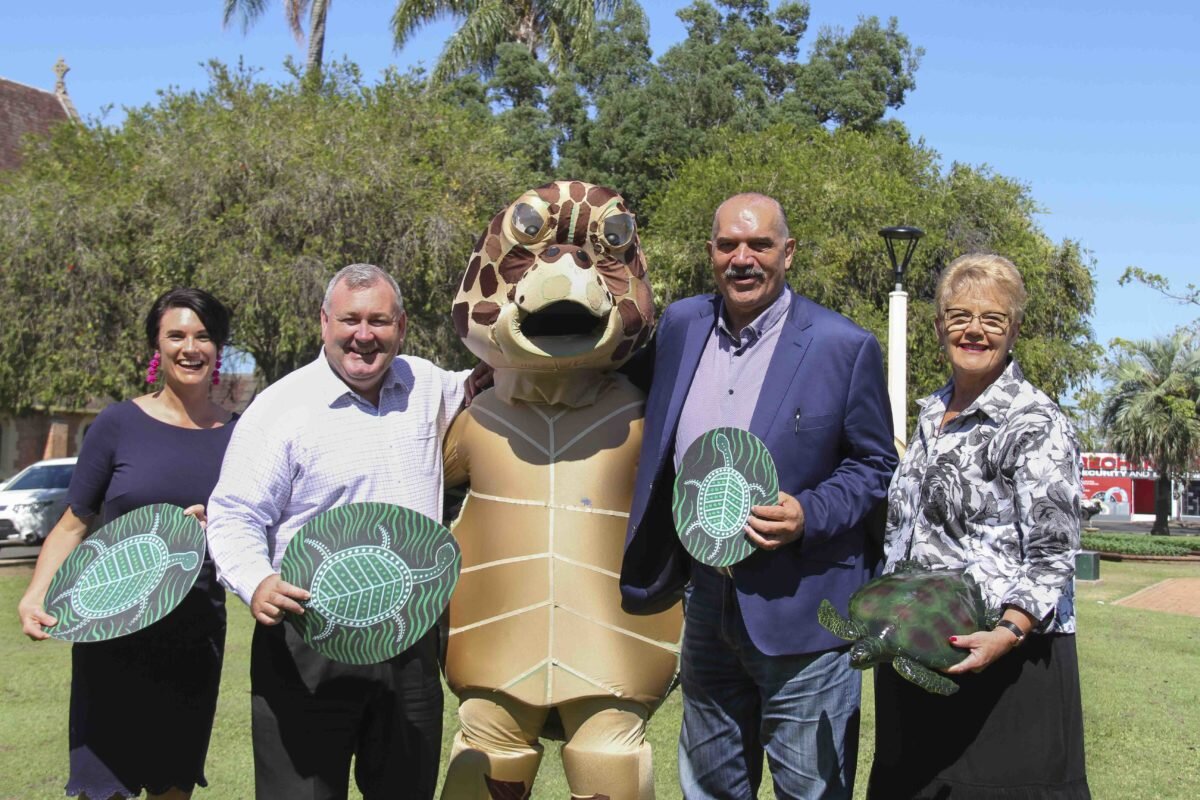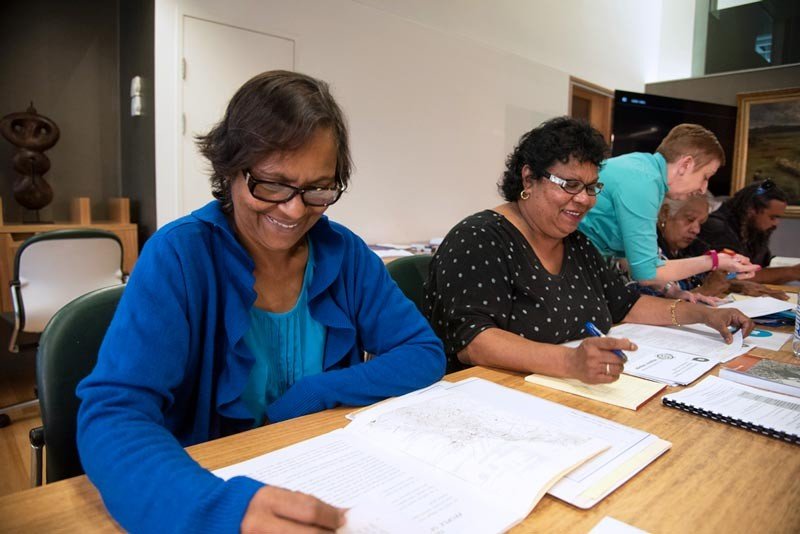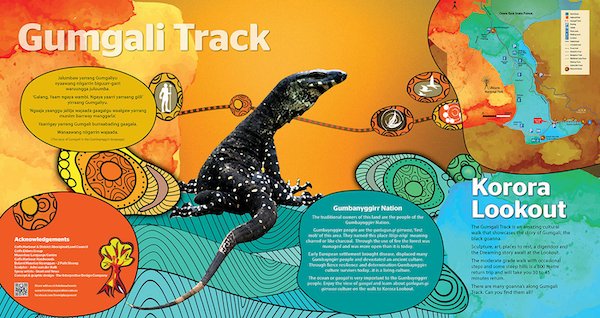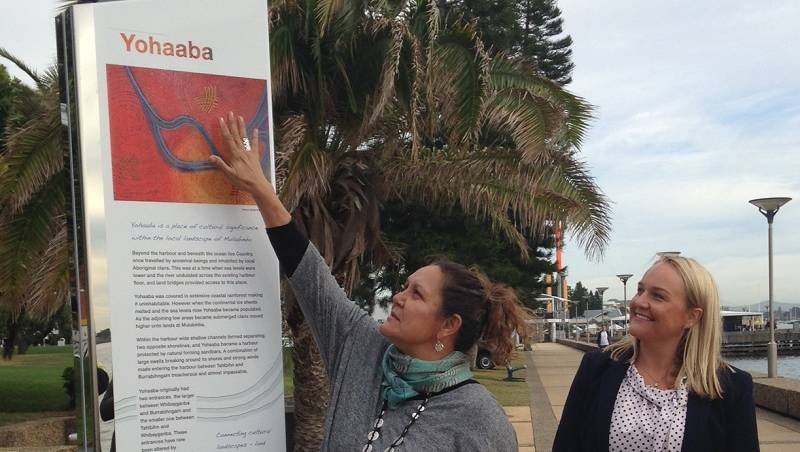
Local Government Councils engaging with Aboriginal and Torres Strait Islander languages
Local government councils, working in collaboration with local language groups can play a pivotal role in the revitalisation of Aboriginal and Torres Strait Islander languages. By considering languages alongside decisions around policy, planning and cultural activities, councils have the opportunity to ingrain first languages into the public dialogue and further support the restoration of the local Indigenous culture.
It is vital to engage with Aboriginal and Torres Strait Islander families, groups and communities in your region when developing activities around Australia’s first languages. By doing so, you ensure all actions and activities follow cultural protocols and are aligned with the revitalisation goals of the language community.
Connecting with Community
Many of the language listings on Gambay: First languages map include links to local Indigenous language centres and programs as points of contact for language advice. Language centres work alongside their community to restore and maintain their language. Not all language groups will have a language centre and further investigation into the language authority or appropriate community leaders will be needed.
For those languages where a link is not provided on Gambay, when getting started it will be useful to have conversations with:
Aboriginal and Torres Strait Islander community organisations.
Schools working with communities to deliver a local language curriculum.
Indigenous ranger groups and the people managing national and state parks across your region.
Local organisations and groups in your area including your libraries, museums and cultural centres.
Click here for additional suggestions on ways to connect.
Suggestions for partnership and advocacy
Festivals and celebrations
Aboriginal languages can play an important role in any of your local events, festivals and celebrations, not just for NAIDOC Week. Inviting performers to sing or tell stories or displaying signage in language are all ways to use the local language as a focus for your community. Theming a festival or celebration with language opens opportunities for community members to become involved and to educate others about their community’s language.
For example, the Milbi Festival is the Bundaberg community’s first ever large-scale Arts and Cultural festival to have an Indigenous theme and utilises the local language, Taribelang. ‘Milbi’ refers to the freshwater turtle and is a word that is also used by neighbouring clans who share the waterways. This festival will showcase language, arts, culture, history and inter-connectedness, all through the use of one language word.
Bundaberg Tourism general manager Katherine Reid, Mayor Jack Dempsey, Gidarjil Development Corporation managing director Kerry Blackman and Cr Judy Peters join Flip the Reading Turtle to announce Milbi Festival.
Performer at the Quandamooka Festival, supported by Redlands Shire Counil. 2019 Theme: Jandai Wuluara, Ngaliya Wulara – Jandai Lingo, Our Lingo.
Cultural tourism
Aboriginal and Torres Strait Islander languages can tell the story of the land, sea, animals and history of places and can provide tourists with a unique perspective when visiting your local government area. By supporting Indigenous owned and operated businesses, local councils can not only showcase this rich history but also support the economic growth of the associated language community.
Councils should consult with local Indigenous businesses and community groups for advice on how best to support their individual needs. Councils could consider engagement opportunities such as marketing and promotions, funding and resources, and paid employment or business engagement opportunities.
Other reconciliation initiatives such as renaming or dual naming using the traditional place names have underpinned strong tourism outcomes for many areas such as Uluru, K’gari and Minjerribah. Further to this, the use of first languages in international events such as the Commonwealth Games has seen unprecedented levels of community engagement with first languages and proved to be pivotal to the identity of the event.
Clan members of the Yolngu people from north-eastern Arnhem Land perform the Bunggul traditional dance during the Garma Festival. (AAP)
Language liaison officers
Language liaison officers play an integral role in embedding language within your community. They are the ‘go to’ people for consultation regarding the successful embedding of language within community projects. The language liaison officer works in collaboration with Language Centres and council and will have a broad understanding of your community’s perspective around language revival. Language officers will support you to take your first steps toward embedding language further within your community.
These positions offer a great opportunity for council to have a skilled local Aboriginal person employed on staff to advise on language matters and help bridge communications between council and constituents.
Language lessons for council staff
Whether you live in a region where your local community speaks a traditional language, contemporary Aboriginal and Torres Strait Islander languages or English as their first language, working with your local language custodians to deliver language lessons for council staff is a powerful way to build engagement across your region. Encouraging your staff to be able to have basic conversations in the language that the traditional owners speak is an important first step in recognising the people and land on which your community is built.
Grant Thompson facilitating a language awareness course for Ngukurr school teachers and council staff. Ngukurr Language Centre.
How libraries can support languages
State and local government libraries have a national Position Statement on Aboriginal and Torres Strait Islander library services and collections and National Indigenous Languages Collections Strategy. They guide libraries in ways to support local language communities with appropriate activities, and collection and access to language materials. Libraries can also offer a range of activities to support and promote languages. This may be through making spaces available for small language classes, research and story telling, or actively collecting and promoting language materials. The State Library of Queensland, for example, works with regional libraries to support community members’ language research efforts across the state.
Dianne Ross Kelly and Jenny Warrak from the North Queensland Language Centre participating in the Research Discovery Workshop at the State Library of Queensland.
Signage
Signs that display Aboriginal and Torres Strait Islander languages acknowledge the traditional custodians and provide a public space to share language and educate others. By incorporating language into signage, you are contributing towards strengthening the language through its practical, everyday use. In consultation with the local language custodians, you can use bilingual signs to give direction in office and outdoor spaces, share stories or recognise the traditional place names of your region.
Gumgali Track signage. Muurrbay Language Centre.
Place naming and dual naming of local sites
One of the easiest acts of reconciliation that a local council can undertake is renaming or dual naming local sites. When your community begins to refer to local places and sites by their traditional name, that language name then becomes revitalised and any significant stories and history associated with the traditional name are restored to the identity of the site.
Renaming initiatives in your region need to engage Indigenous community members.
These initiatives are well exemplified by significant community collaborations such as Uluru, K’gari and Minjerribah. Each of these significant places were renamed to their traditional Aboriginal name, generating the opportunity to further promote and celebrate place and culture.
Artist Saretta Fielding, who created artwork for the interactive dual naming signage depicting the Hunter River, joins Newcastle Lord Mayor Nuatali Nelmes to unveil the first of the eight signs on the Joy Cummings Promenade.
Ranger programs
Involving your local language within ranger programs can be rewarding for those involved in the program and particularly empowering for Aboriginal and Torres Strait Islander rangers. Promoting language within the environmental sector provides more opportunity to learn and understand Aboriginal ways of Caring for Country and gives insight into traditional agricultural and horticultural techniques. These programs can also provide sustainable employment for Indigenous people in your region around which to develop and grow language services for communities, schools and other council partners.
Birriliburu Aboriginal rangers and Bush Heritage scientists work together on conservation efforts. (Photo credit: Annette Ruzicka)
Local grants for community language programs
Creating grants for community language programs, or incorporating first language use into your local grants criteria, can establish major incentives for community-based projects to involve first languages and build your regions capacity towards their reclamation process. Grants that support first language work will provide a platform for community led language revitalization activities and support languages that are listed as endangered.
Working with your language centres
Language centres maintain strong community links between traditional custodians and members of other languages groups supported by the centre. Language centres are the best point of reference for local councils wanting to begin embedding first languages within the broader community. Councils are increasingly realising that a strong partnership with your local language centre will have a positive impact on the community. For this reason a number of councils have now committed to providing ongoing funds to support the language centre in their region.
Local mapping of land and sea
The language of the land teaches us who’s Country we are on, and each local language will have particular words that describe parts of their environment, land and waterways. When you come across language that refers to or describes the Country and the sea, this gives you a link to the traditional custodians. This rich and valuable form of authentication is known as the language of the land. Learning your local language also supports you to better understand the cultural histories of your region. Your local language will describe the Country to you and can be traced out to the boundaries of that land.
Councils can work with Aboriginal and Torres Strait Islander language groups to incorporate these unique identifying words into geographical resources or could engage Indigenous rangers and traditional owners to teach council staff on Country, supporting a collaborative approach to environmental management.
Naming buildings, rooms and local sites
Renaming buildings, rooms and local sites is an effective way to promote the local language and provide a forum for community to gain further interest and awareness. The newly named spaces or buildings when referred to, will see the language name used frequently and hold the potential to provide broader education opportunities around the community, history and culture associated with the language.
Language as artwork
Indigenous artists often draw upon the stories and language of their people as inspiration for their artworks. Commissioning artworks from Indigenous artists for public spaces gives an opportunity for the community to share in these stories and see the language expressed in a different form.
Councils can further support community engagement through the creation of directions, signage and resources that support these public installations, all featuring the first language.
Mural by Noongar/Arrernte Artist, Jade Dolman. J.D. Penangke
Native garden with traditional names
An innovative way to entertain and educate is to create a native garden in collaboration with local Aboriginal and Torres Strait Islander community members. The local language will have unique names for the native plants and using them throughout the garden further supports the continued use of the language.
It can also provide a space for Elders to meet and share stories with children, and learn about bush tucker and the importance of caring for Country.
Welcome to Country signage and acknowledgement of Country
Welcome to Country signage is a symbol of respect for the traditional custodians of your area. Incorporating language into your Welcome to Country sign takes a step away from the generic Welcome to Country statements and moves towards one that is authentic and more representative of your community. Work with your nearest language centre to develop a statement that is appropriate for your community.
The language custodians can also help council staff incorporate language in their acknowledgment of Country statement, used when speaking on Country. This must be personalised and spoken from the heart. Authentic acknowledgment comes in the form of utilisation and implementation of your community’s first language and commitment to its survival.
Greeting people in the local language
Greeting people in the local language is one of the most effective ways to promote the language. Language greetings are excellent conversations starters when council officers open meetings and public events, or simply answering the phone. Using a local greeting, with the permission of the traditional owners, can help raise cultural awareness and demonstrate that council is willing to partner with the local community to help them reach their language goals.
Employment opportunities
As languages are increasingly incorporated into many aspects of community activities, the expertise of skilled language workers will be required to support all sectors of community and local government throughout the processes. Employing community-supported language workers within your council staff will open many opportunities for them to strengthen the use, community knowledge and social value of your area’s first language.
Local histories
When researching the local history of your area you may find resources that include language. Language words can describe cultural and historical events in more detail than we can with English. By working with local language workers, councils can unlock the hidden truths of the local history through a better understanding of the language of the land. Understanding language in research can also give a perspective on cultural practices, ecological knowledge and sociological relationships. For example, specific words referring to kinship, words that describe relationships with other countrymen, seasonal terms and other environmental details.
In partnership with the local language centre or group, find ways to promote this specific language to showcase how sophisticated, relevant and specific first languages are.
Reconciliation Action Plans
Embedding language within your Reconciliation Action Plan is a nice way to begin discussions with the community about the languages of your region, the community’s aspirations for their languages, the benefits of language activities and strength, and how council can support traditional owner efforts toward their language goals.
City of Belmont, Reconciliation Action Plan
Cultural walks and pathways
Walking paths are engaging ways to learn the languages and as you walk through the environment. Cultural walks and pathways help share an understanding of the Country and the way that Aboriginal people have lived for tens of thousands of years. Cultural signage that includes significant use of local language can be a major point of difference between your region and the next and attract more visitors to your area. Trails and signs are a resource for the entire community to enjoy, encouraging curiosity and interest for first languages from residents and visitors alike.
Nyoongar Trail at Karnup Reserve. City of Rockingham.
















